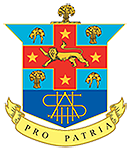History
“Hurlstone began in the inner-city Sydney Suburb of Ashfield in the 1870s. The man who started the first Hurlstone School was John Kinloch. He was born in Dublin in 1832 and migrated to Australia when he was 4 years old. He was the only surviving child of John Kinloch senior and his wife Helen Hurlstone who died prematurely of influenza when John was sixteen. John later went to Sydney University and studied Mathematics. He was also a fine sportsman and played cricket for NSW.
After many years as tutor of Mathematics at Sydney University he decided to build his own private school. In April 1874 Kinloch purchased land where Trinity Grammar School and Yeo Park stand today; adjacent to Canterbury Road in Ashfield. He paid 1734 pounds and 10 Shillings. Kinloch called the school Hurlstone after his mother’s maiden name. He built a large administration block, part of which still exists and houses the headmaster of Trinity Grammar. There was also a large boarding house block and stables and quarters for domestic staff.
Kinloch could not attract sufficient numbers of students to make the school pay and he was forced to sell to pay off his substantial debts. He subdivided the land and put it all up for sale. The government of the day led by Premier Sir Henry Parkes stepped in and purchased the entire area to be used as a residential women’s teacher’s college. Kinloch took the money, 5520 pounds, and embarked on a career as a real estate agent that lasted until the depression of the 1880s. He then returned to his original profession as a mathematics teacher tutoring students for university entrance.
For almost a quarter of a century young ladies walked in the large grounds that had been Hurlstone College studying literature, poetry, playing tennis and preparing for careers in education. In 1907 the ladies moved to the new Teacher Training College in the grounds of Sydney University and Hurlstone Agricultural Continuum School was born.
Hurlstone was initially modelled on a school in Vilvorde, near Brussels that trained students in practical agriculture. The principal of Forte Street High, Mr. J. W. Turner, advocated a similar institution in NSW. The Director of Education and the government of the day decided to establish a school that would carry on the ordinary school education of boys beyond the primary standard and give a grounding in the elementary theory and practice of agriculture.
The first Principal of this new school was Frank McMullen. He was thirty-five years of age with twenty years of teaching experience. He had previously been principal at Lindfield in Sydney. McMullen had a Master of Arts from Sydney University and had completed courses in advanced agriculture and experimental agricultural chemistry. He was principal from 1907 to 1916.” (Pollock A. (2007). Bedbugs, Daygos and Slabs. Marrickville NSW, Southwood Press Pty Ltd.)
In those days most students completed their schooling after primary school and students at ‘Hurlstone Agricultural Continuation School’ (as it was known at the time) studied there for only two years. In 1926 the school moved to its present site in Glenfield, approximately 42 km south-west of Sydney (between Liverpool and Campbelltown) and adjacent to Glenfield railway station. By then its student numbers had grown from 30 in 1907, to 148. The school supported government policy to promote productivity in the agricultural sector through the training of boys in all aspects of agricultural sciences and farm management.
For a brief period in the early 1940s it was known as ‘Macarthur Agricultural High School’ in honour of wool-grower John Macarthur, but it soon reverted to its previous name.
Hurlstone was a boys’ school until 1978, and it became co-educational from 1979.
